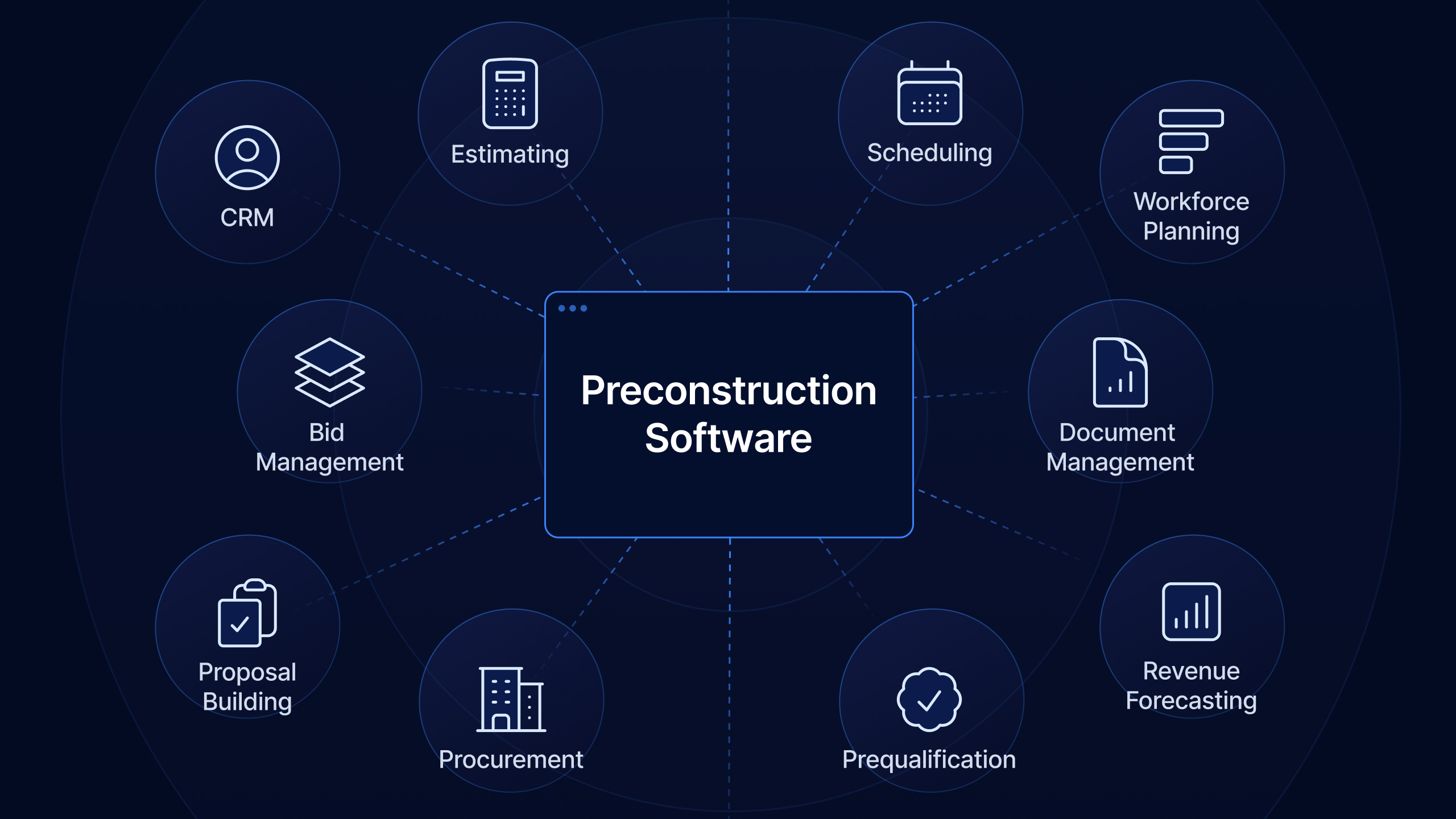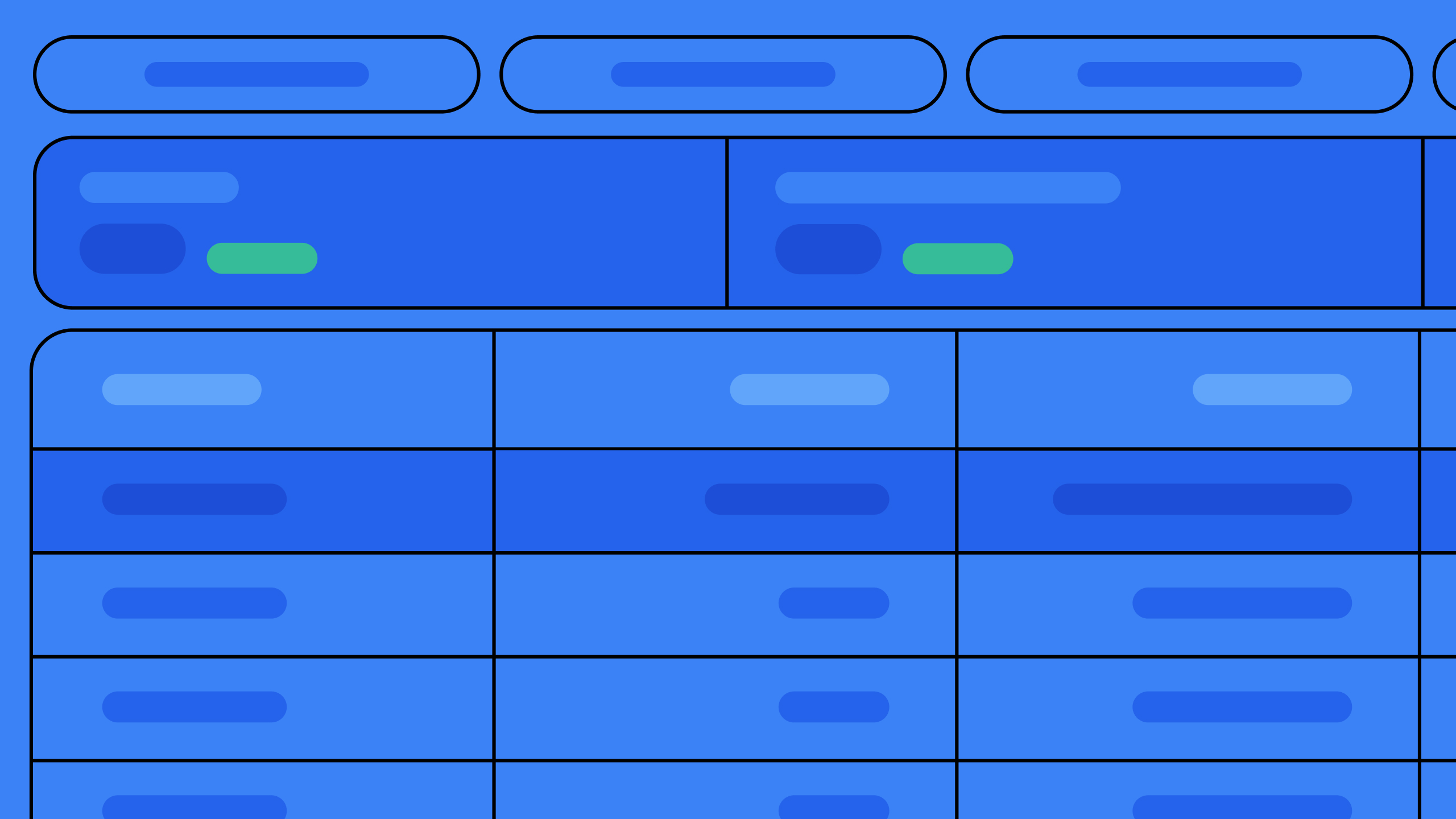
Preconstruction Software: The Comprehensive Guide
What preconstruction software is, why it matters, and how to pick the best option
April 3, 2024
9 min read
Learnables

Edward Gonzalez
Founder at Buildr

What is preconstruction software?
Preconstruction software refers to a tool or suite of tools designed to aid in any of the various tasks or workflows that make up the preconstruction phase of a project.
The preconstruction phase generally encompasses all the prospecting, planning, design, and preparation stages prior to a builder passing the project off to its course-of-construction teams—that vital journey from lead to project conception to groundbreak.
Business development, operations, marketing, estimating, preconstruction, and leadership are the departments of a general contractor that primarily benefit from preconstruction software. The core functions of various preconstruction software include, but are not limited to:
CRM (Client relationship management)
Workforce planning
Document management
Revenue forecasting
Cost estimating
Procurement
Bid management
Prequalification
Proposal building
The use of preconstruction software is meant to scale human efforts, in spite of any foreseeable labor shortages, by heightening collaboration and automating repeatable tasks wherever possible. When well-adopted, preconstruction software becomes foundational to a company’s entire business process, vastly improving strategic decision-making, overall productivity, and ultimately profit margins.
In short, preconstruction software lays the foundation for not just a successful project but a successful business. Its adoption is a strategic decision by a general contractor to either remain the best builder in its market or grow to become it.
Why does preconstruction software matter in 2024?
A preconstruction phase conducted with singular focus and collaboration is paramount to a project’s success—nothing new there.
In 2024, preconstruction software matters more than ever because an expedited preconstruction phase coupled with construction’s growing labor shortage paves the way for preconstruction software to effectively bridge both gaps of timeliness and manpower.
When a project’s preconstruction is more effective, the higher the profitability, the lower the risk, and the more on-point the project delivery within budgetary and time constraints. Conversely, project delays, budget overruns, inaccurate revenue forecasting, over-utilized staffs, and safety issues can be directly linked to ineffective preconstruction.
A shorter preconstruction phase post-pandemic
Preconstruction’s technological optimization has gained plenty of traction in the wake of Covid-19. The pandemic forced the industry to slow down and reevaluate itself. What it found was that preconstruction was needlessly fraught with isolated planning and uncommunicated challenges between stakeholders.
Forced distancing forced closer communication between owners and general contractors. More progressive and inclusive delivery models helped relieve the strife present in preconstruction pre-pandemic.
The catch was that better communication led to shrinking timelines—a 33% shorter preconstruction phase estimates Mortenson—which puts pressure on designers, planning, and material procurement. Add on the already-present skilled labor shortage in construction and you can see why GCs at large are in desperate need of collaborative preconstruction software to help them do the best with the limited resources they have.
Through the effective use of preconstruction software, general contractors can:
Stay up-to-date with expedited project timelines,
Fine-tune pursuits based on historical data,
Determine and address potential problems early on,
Minimize budget overruns and mitigate safety risks—
—all while adeptly managing and maintaining their existing clientele. To-do’s and follow-ups slipping through the cracks are things of the past.
A less-than-ideal preconstruction process triggers "all sorts of plan and drawing inconsistencies, inefficient supply and material purchasing, poor trade coordination and often heavy cost and schedule overruns that only reinforce the animosity between already isolated stakeholders."

What are the essential features of preconstruction software?
Not all preconstruction softwares were created equal. Below are some of the essential features to keep in mind when vetting solutions. Take stock of these and add your own to a list of the features that matter most to you and your business. When it comes time to compare options, it'll make things much easier when you can pit different solutions' features against each other.
For more of a deep dive into the listed features below, be sure to check out our blog The 7 Essential Features of Preconstruction Software.
User-friendliness
Ask any of your peers why a certain tech adoption failed at their company and the answer more than likely will be: “it just wasn’t very user-friendly.”
For any software, not just for preconstruction software, user-friendliness is the most important attribute. When collaboration and efficiency are the North Stars of your software hunt, it would be counterintuitive to adopt a system that’s difficult for anyone to use. The more user-friendly and intuitive a solution is, the smoother and shorter the implementation, the cleaner and more aesthetic it’ll look, and the overall happier your teams will be.
User-friendliness also ensures that there’s a low learning curve. This means a team member possessing any level of tech-savviness can hop in and navigate the software with ease.
Centralized data
The ability for multiple team members and departments to have access to the same source of data is vital for any general contractor. Siloed data creates more spreadsheets, more meetings, more “needing to get on the same page,” and a much higher difficulty to make data-informed decisions. With data lives in multiple places, it has the habit of being lost due to human error, employee departure, or simply losing track of where it is.
Centralized data improves accessibility, organization, and overall efficiency. Since speed and doing the most with the manpower you have are key motivators of preconstruction software adoption, centralized data is a must. Your data deserves to be consistent and accurate—the answer, then, is a single-source-of-truth.
Data consistency is one of the reasons why we developed Buildr to be a preconstruction platform rather than a preconstruction point solution. The more point solutions you have, the more paths data have to travel through to to stay flush across the board.
Collaboration
Aspects of preconstruction software meant to foster collaboration are vital for facilitating real-time communication and coordination among all project stakeholders. Whether it's sharing updates, tagging team members to facilitate a task, making adjustments, or making critical decisions, effective collaboration features ensure everyone stays on the same page, reducing misunderstandings, unneeded meetings, and any sort of delays.
Collaboration eliminates silos of knowledge that slow processes down. When everyone acts together as if they had a single brian, your preconstruction teams can move much more efficiently and agilely. Gone are the days of "we have one marketing person that uses our CRM."
A well-built mobile app
Here’s a shocker: business just doesn’t happen in the office. In today’s world, our phones are omnipresent, always in our hand, and thus much more accessible than desktop computers. This means that having a mobile app version of a preconstruction software enables team members to access information, communicate, and make decisions no matter where they are, ensuring project progress isn’t hindered whether you’re on a job site or a golf course.
It's worth noting that just the fact that a preconstruction software has a mobile app isn’t enough—it has to be as close to 1:1 with the software as possible. A clunky mobile experience is sometimes worse than no experience at all. To read our picks for the most essential features of a preconstruction mobile app, be sure to check out our blog on the topic.
Integrations with other software
When adopting preconstruction software, you should always ask yourself: “How will this solution fit into the rest of my tech stack?”
The capacity for integrations with other construction management tools and systems, such as email and course-of-construction software, is critical. This interoperability ensures a streamlined workflow, minimizing data silos and enhancing overall project efficiency. Some departments may primarily use different software, so good integrations ensure continued collaboration.
Point solutions especially require best-in-class integration with other tools you’re already using. The nature of point solutions is that they're only a piece of the whole. When pieces of software don’t talk to each other very well, data naturally gets siloed, undoing part of why you decided to adopt preconstruction software in the first place.
Business insights and reporting
A software that houses data is only as good as its ability to parse and prescribe a more fine-tuned strategy from that data. Otherwise, you're essentially signing a contract for a very expensive version of a spreadsheet. Preconstruction software should empower your teams to answer its most important questions and make more informed decisions.
To check out our picks for the 5 most important features for prescriptive data reporting during preconstruction, be sure to our blog "Business Insights: Building a more informed future during preconstruction."
What are the best options for preconstruction software?
There are countless preconstruction software solutions on the market that range from point solutions to full-on preconstruction platforms. Each have their own pros and cons, so be sure to do your research.
It’s always beneficial to ask your network what tools they recommend. When demoing a product, it never hurts to ask to be connected with one of the tech company's existing customers.
Below is just a small sampling of the myriad of preconstruction software options out there—
Buildr
Buildr is the industry’s first cloud-based preconstruction platform built for general contractors. It’s an all-in-one customer relationship management (CRM) system and workforce planning solution that unites preconstruction teams, increases profit margins, and helps GCs make data-informed decisions. Featuring an unlimited seat model and built-in integration to Procore and email/Office 365, its emphasis is on collaboration and user-friendliness.
Procore
Procore, one of the industry’s leading course-of-construction platforms, has recently extended its product offerings to preconstruction.
Concntric
Concntric is a preconstruction platform that caters to general contractors, owners, design teams, and subcontractors. Its goal is to "make the built world more affordable predictable and sustainable."
Bridgit
Bridgit is a workforce planning point solution based out of Canada featuring "real-time updates, next-generation forecasting, and seamless integrations."
STACK
STACK is takeoff and estimating software. It boasts "10x faster bids and up to 35% more opportunities to win."
Buildertrend
Buildertrend is a construction project planning, estimating, customer management, and subcontractor scheduling solution.
Zebel
Zebel is a cloud-based software to create cost estimates based on historical data.
PipelineSuite
PipelineSuite is a cloud-based bid invitation software solution with an integrated online plan room and optional prequalification module for general contractors.
ProEst
ProEst is a cloud-based estimating software that lets you create more competitive bids in about half the time.
What defines the best preconstruction software?
The first step in defining the best preconstruction software is to pinpoint which solutions align with what your projects uniquely require as well as what integrates within your already existing systems and workflows. For some builders, a point solution puzzle piece to fit into your robust pre-existing system may be the answer. For others, a full overhaul and transition to a preconstruction platform may be the move.
At the end of the day, the right preconstruction software for your company will empower your teams to collaborate better, make data-informed decisions, automate tasks where possible, and maintain control and visibility over project timelines and budgets, setting the stage for well-executed, highly profitable projects.
Featuring unlimited seats, unlimited in-house support, and unlimited custom fields
Stay in the loop
Seriously, you should sign up to be a construction insider. Everyone will be so jealous of you.